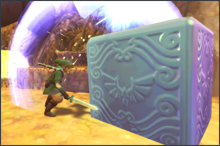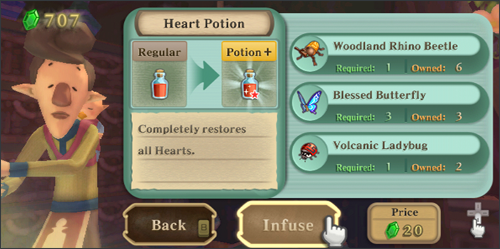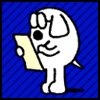Rewards and Character Building in Skyward Sword
Posted on January 20 2012 by Hanyou
 The Zelda franchise is famously premised on exploration. The original Legend of Zelda offered a world one could literally get lost in. Different mechanics — ranging from action to puzzle-solving — affected the way the player explored the world, but there could be little question that the whole purpose of the game was to discover.
The Zelda franchise is famously premised on exploration. The original Legend of Zelda offered a world one could literally get lost in. Different mechanics — ranging from action to puzzle-solving — affected the way the player explored the world, but there could be little question that the whole purpose of the game was to discover.
Zelda games have always struck an interesting balance. Like Nintendo’s other major adventure franchise, Metroid, Zelda games offer the player items which both advance the story and supplement combat; they also offer power ups that allow the gamer to customize Link. This happened at a very rudimentary level in the original Legend of Zelda — rupees allowed Link to collect optional items which made dungeon crawling easier, while some items acquired from the dungeons were, at least on the surface, absolutely necessary to enter the final dungeon and fight Ganon. Items like the Triforce pieces served no purpose from a gameplay perspective, but broke other barriers to progression. This basic formula, balancing essential and useful items, nonessential items that helped make the game more customizable and in some ways easier, and essential items that served no gameplay purpose, has not been absent from any Zelda title. If Zelda games are about exploration, it’s items and collectibles that both facilitate and reward exploration. It’s the thrill of making Link stronger and opening up new areas of the world that makes Zelda games, at their core, so addictive.
Make no mistake; at base, Zelda games are, and always have been, glorified scavenger hunts.
What Skyward Sword presents is arguably the most rewarding, most extensive, most well-designed scavenger hunt yet. More than any Zelda game before it, exploration is incentivized with a constant stream of rewards for any gamer who’s alert to his or her surroundings. Every location offers bugs, rupees, Goddess Cubes, and various other items to collect. Perhaps most importantly, these items can be used for several purposes, multiplying the possibilities for customization and the relative value of every collectible.
 For an early example, consider the Deep Woods, a small section encountered before the first dungeon in the game. The first time the player treks through it, they might be driving forward into the dungeon to advance the main quest, but if they look around, they’ll notice things. Bugs, birds, and flowers dot the landscape. Enemies offer rupees and monster horns. There may even be a Goddess Cube or two lying around for players to find later on. Rarely will anyone wring much gameplay out of any given part of the overworld on the first trip through — and even if they do manage to collect several items, they might not have anything to do with them until later in the game.
For an early example, consider the Deep Woods, a small section encountered before the first dungeon in the game. The first time the player treks through it, they might be driving forward into the dungeon to advance the main quest, but if they look around, they’ll notice things. Bugs, birds, and flowers dot the landscape. Enemies offer rupees and monster horns. There may even be a Goddess Cube or two lying around for players to find later on. Rarely will anyone wring much gameplay out of any given part of the overworld on the first trip through — and even if they do manage to collect several items, they might not have anything to do with them until later in the game.
Allowing the gamer to harvest such a multitude of items has benefits that reach well beyond the scope of the gameplay itself. It also enriches the world. The fact that certain bugs, flowers, and rocks can only be found in certain locations gives those locations a unique character. Giving the gamer the opportunity to learn where items are — either through experience or through dialog with other characters — makes thorough exploration advisable. This plays off of the main quest well, as the main quest also encourages the gamer to retread old ground.
This is a logical evolution of the Gold Skulltulas, Poes, Joy Pendants, and Secret Seashells. The difference is that the items in Skyward Sword are in limitless supply, and they’re numerous enough that specific types can be found only in certain areas. The concept of the non-essential collectible has been expanded to maximize freedom and customization on the part of the player, and it makes for a more rewarding experience. It also makes exploration more important.
Once Link has attained the items he needs, the Bazaar gives him countless options for how to use them. The eventual eight adventure pouches — acquired only after the player has collected a significant number of rupees — encourage both experimentation and collection. Different in-game situations may call for an abundance of different items; a particularly hard boss might require less skilled gamers to invest time, and space, in upgraded Heart Potions, while rooms packed with enemies might call for four or five maxed out quivers. These are some of the best and most useful non-essential rewards a Zelda game has yet offered. While bottles, heart pieces, and larger bomb bags are hardly new to the series, allowing the player to micromanage their inventory to this extent certainly is. It’s integral to the process of item collection, too; without worthwhile rewards, few items reach their maximum potential easily, so there is always a reason for the player to endure the optional collecting quests. While most scavenger hunts in recent Zelda games have been one-time affairs, requiring skillful navigation of a mini-dungeon or a prolonged fetch quest, these quests rely strictly on player input.
It’s not just rocks, flowers, and bugs that add to the breadth of character building and exploration in Skyward Sword; conventional quests involving non-player characters also offer more rewards. Like the sidequests in Majora’s Mask, many of the sidequests in Skyward Sword have multiple stages. These individual phases might allow players to further explore the surface or the sky, facilitating non-essential item and rupee collection, but ultimately, the goal is to get Gratitude Crystals. There’s almost always a short-term reward as well, whether it’s rupees, heart pieces, or simply more character development for the NPCs. Often, completing sidequests can lead to more sidequests.
While this isn’t necessarily exclusive to Skyward Sword, the way each of these elements interface with each other does make for a brand new experience in a number of respects. Zelda games have become increasingly linear with nearly every iteration. Skyward Sword not only offers a purely linear quest with dungeons and tasks that must be undertaken in a specific, preprogrammed sequence, but it rarely allows players to open up new areas of the world until it prepares them for it. The developers at Nintendo have decided to broaden each individual area and infuse it with more character through the use of collectibles, perhaps as a replacement for the previous freedom Zelda games offered. This is not just a subtle difference in design, but the kind of radical shift in gameplay we rarely see between entries in the Zelda franchise. It’s an incorporation of a mechanic that has served other genre’s games well, and adds potentially limitless replay value to this one.
Opinions may differ on how well it’s implemented or on how solid the customization options actually are. Ultimately, what matters is that they have expanded and built on the solid principle which made the franchise popular in the first place. Exploration — through sidequests, through the main quest, and through simple time-wasting — has become more rewarding, and as a consequence the gameplay possibilities for the franchise at large have expanded. Perhaps this added freedom and customization will prove as malleable and engaging for the developers as it is designed to be for the gamers.





